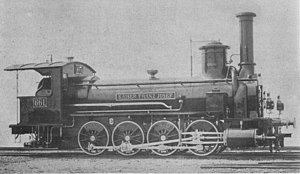StEG I 600-711
|
StEG I 600–711 / StEG V / StEG 42 / kkStB 571 / BBÖ 571 MÁV IVb 4201–4242 / MÁV 459 / ČSD 401.0 DR series 55 70 / CFO 243–246 / BDŽ 1243–1246 |
|||
|---|---|---|---|

|
|||
| Technical specifications | |||
| design type | D n2 | ||
| Cylinder Ø | 470 mm | ||
| Piston stroke | 632 mm | ||
| Drive wheel Ø | 1,173 mm | ||
| fixed wheelbase | 2,535 mm | ||
| Total wheelbase | 3,793 mm | ||
| Total wheelbase + tender | 9,750 mm | 9,800 mm | 11,457 mm |
| Number of pipes | 206 | 185 | 195 |
| Heating fl. d. Tube | 169.2 m² | 152.0 m² | 159.0 m² |
| Heating fl. d. Fire box | 9.8 m² | 9.4 m² | 9.5 m² |
| Grate | 1.96 m² | 1.88 m² | 1.85 m² |
| Vapor pressure | 9/10 | ||
| tender | 37 | ||
| Weight (empty) | 40.9 t | 40.2 t | |
| Adhesion weight | 46.1 t | 45.7 t | |
| Service weight | 46.1 t | 45.7 t | |
| Vmax | 35 km / h | ||
The steam locomotives StEG I 600-711 were freight train - Tender locomotive of the State Railway Company (StEG).
Due to the topographical conditions of the routes it operated, the StEG had to switch to four-coupled freight locomotives as early as 1868. From 1868 to 1880, 75 units were delivered by the company's own locomotive factory , by the Esslingen machine factory and by Borsig . With their tall steam domes with connecting pipes, the machines had a very ancient appearance, to which the riveted counterweights on the wheels also contributed. However, around 1900 most of them got new boilers. The locomotives were stationed in Stadlau , Brno and Böhmisch Trübau , among others .
Of the numbers 600–711, only 600–637 and 698–711 were occupied. In the second designation scheme of the StEG, the vehicles received the numbers 1112–1149 and 1210–1223 and the category V. In addition, the numbers 1224–1246 were occupied with newly built locomotives of this type. In the third designation scheme of the StEG, the vehicles were given the designation 4201–4273.
In the course of the nationalization of the Hungarian routes of the StEG, 42 of these vehicles came to MÁV as IVb 4201–4242 , which they assigned to the 459 series in 1911. The kkStB arranged them after the nationalization as a series of 571 a.
After the First World War , 40 units came to the BBÖ and 31 to the ČSD , which from 1924 onwards classified them as the 401.0 series . The two remaining machines came to PKP , which they soon retired.
The Deutsche Reichsbahn lined up three copies in 1938 as 55 7001–7003. All three survived World War II and, like the last Czech 401.0, were eliminated in 1952 .
Chemins de fer Orientaux (CFO) received four identically constructed locomotives in 1878 from the StEG locomotive factory for the railway from Ruse to Varna in today's Bulgaria with the numbers 243 to 246, which was then in the European part of the Ottoman Empire . In 1888 they and their route were transferred to the newly founded Bulgarian state railway Balgarski Darschawni Schelesnizi (BDŽ), which they took over with the numbers 1243 to 1246, but from 1908 re-assigned them the old CFO numbers. They were retired from BDŽ before 1936.
literature
- Directory of the locomotives, tenders, water cars and railcars of the kk Austrian State Railways and the state-operated private railways as of June 30, 1917 , 14th edition, published by the kk Austrian State Railways, Vienna, 1918
- Karl Gölsdorf: Locomotive construction in old Austria 1837-1918 , Slezak publishing house, Vienna 1978. ISBN 3-900134-40-5
- Helmut Griebl, ČSD steam locomotives , part 2, Slezak publishing house, Vienna, 1969
- Helmut Griebl, Josef-Otto Slezak, Hans Sternhart: BBÖ Lokomotiv-Chronik 1923–1938 , Verlag Slezak, Vienna, 1985, ISBN 3-85416-026-7
- Heribert Schröpfer: Traction vehicles of Austrian railways - steam locomotives BBÖ and ÖBB , alba-Verlag, Düsseldorf, 1989, ISBN 3-87094-110-3
- Johann Stockklausner: Steam company in Old Austria , Slezak publishing house, Vienna, 1979, ISBN 3-900134-41-3
- Johann Blieberger, Josef Pospichal: Encyclopedia of the kkStB-Triebfahrzeuge, Volume 3. The series 61 to 380. bahnmedien.at, 2010, ISBN 978-3-9502648-6-9
Individual evidence
- ↑ Dimiter Dejanow: The locomotives of the Bulgarian State Railways . Slezak, Vienna 1990, ISBN 3-85416-150-6 , p. 10
- ↑ Wolfgang Lübsen: The Orientbahn and its locomotives . in: Lok-Magazin 57, December 1972, pp. 448–452